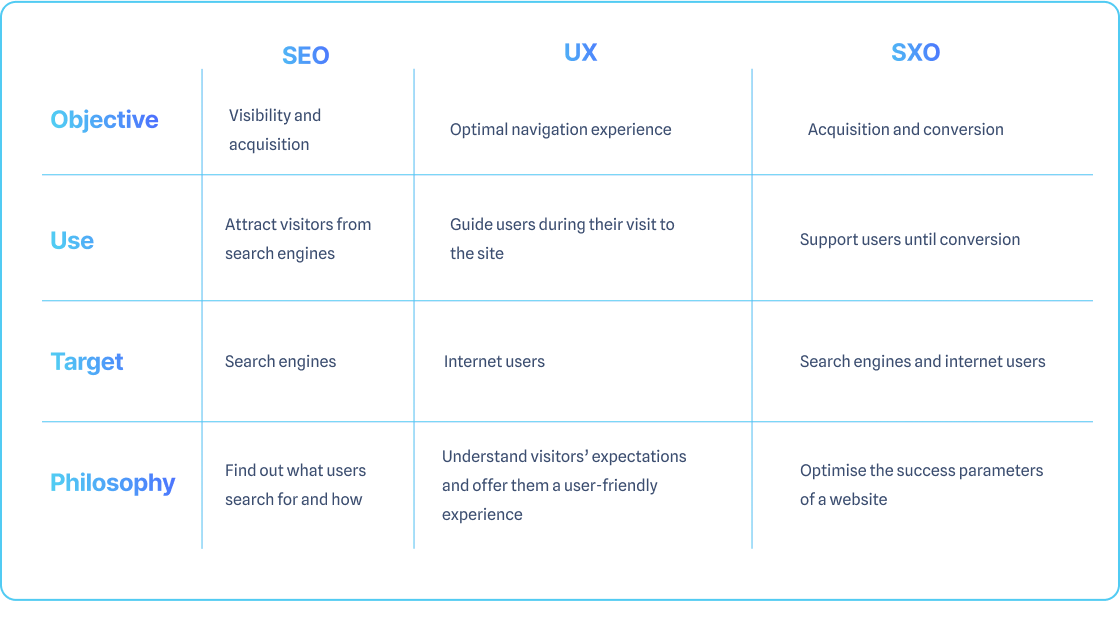
SXO: Search Experience Optimisation
SXO is the combination of SEO (search engine optimisation) and UX (user experience). Find out how to optimise the search experience on your website.

What is Search Experience Optimisation?
What is SXO?
SXO stands for Search eXperience Optimisation, which is the practice of using various techniques to improve the experience of visitors to a website. It involves optimising all stages of the digital journey, from search engine results to the completion of an action on the site. The goal is to enhance the user experience by making it complete and comprehensive, with the ultimate aim of reducing the number of clicks a user has to make to find what they are looking for. This means ensuring that the site provides all the information the user needs so that they don’t have to go back or leave the site to search again. Therefore, it’s crucial to provide a seamless and holistic user experience.

SXO: The Perfect Blend of SEO and UX
Search Experience Optimisation (SXO) brings together the principles of UX and SEO to create an optimal user experience. To fully grasp the concept of SXO, it’s important to understand the underlying principles of these two disciplines and how they complement each other.
-
SEO
Search Engine Optimisation (SEO) is focused on optimising a website’s position in search engine results to increase its visibility and generate more traffic. However, SEO alone cannot ensure that users will stay on the site, as it’s equally important to provide a user-friendly experience that meets their needs.
-
UX Design
User Experience (UX) design is focused on how visitors navigate a website and interact with its content. From ergonomics and site structure to graphical and textual choices, UX aims to provide a high-quality and satisfying experience to users. By providing easy access to the information visitors are looking for, UX optimisation helps to drive conversion and increase engagement.
-
SXO
SXO brings together the two previous approaches to create a seamless journey that addresses all aspects of the search experience. This discipline tackles two key questions: how can we ensure that users find this particular site among the vast amount of content available? And once they’re on the site, how can we guide them to the information that will drive conversions?
Comparison:
SEO, UX and SXO
Why is SXO so important?
The emergence of SXO is in response to the changing criteria for natural referencing, which themselves reflect the expectations of users. In the past, the relevance of a web page was measured based on the density of the main keyword and the number of backlinks (external links pointing to the pages of the site). But over time, search engines began to evaluate the overall performance of websites, taking into account on-page optimisation, content quality, popularity, purely technical aspects (such as page loading time), and, of course, user experience. In short, search engines want satisfied users, and optimising the search experience is a lever for improving satisfaction.

Good to know
SXO is a fusion of the best practices from both SEO and UX design. If you’re thinking of implementing this strategy for your website, it’s best to seek the assistance of a digital agency that specialises in both natural search optimisation and user experience.
How to develop (and deploy) an SXO strategy
Optimising the search experience: A multidisciplinary approach

Implementing an SXO strategy is a major challenge due to the diversity of optimisation levers to activate. By its very nature, this approach combines practices of natural referencing and UX Design techniques, as well as content marketing actions, methods from conversion strategies (CRO – Conversion Rate Optimisation), a bit of web development (for technical aspects), and the mastery of performance indicators to be analysed to measure results. In addition, recurrence is essential: because SXO relies on user behaviour, it is essential to monitor evolving needs and continuously improve your website over the long term. Here are the three major points to work on to deploy an effective SXO strategy.

SXO: SEO and Technical Elements
The approach of Search Experience Optimisation heavily borrows from SEO, particularly in terms of its technical aspects. Therefore, in an SXO strategy, the following points will be given priority attention.
-
Optimising web pages
On-page optimisation is one of the most important aspects of SEO. This involves filling in HTML tags (such as title, meta description, Hn titles, alt attribute for images) with strategic keywords that inform both crawlers and users. Schema.org markup can also be used to create structured data.
-
Page load time
The speed at which a page loads is a user experience criterion, but it is also a ranking factor that search engines consider. When a page loads too slowly, users tend to leave without waiting, resulting in a higher bounce rate. Therefore, optimising the technical aspects of pages contributes to keeping users on the site.
-
Site security
Internet users want to know that their data is protected, so they tend to be wary of insufficiently secured sites. Switching to HTTPS is therefore an essential part of SEO since browsers indicate which sites are protected or not (e.g. with the small padlock icon in the search bar).
-
Mobile display
Mobile devices account for 64% of all internet traffic. Therefore, a website cannot ignore the importance of mobile compatibility, and its page design must be adapted to different screen formats. This is especially crucial since Google prioritises mobile versions of sites in the SERP.
SXO: Navigation and User Experience
The core of the user experience lies in two key aspects: smooth navigation and usability. SXO draws heavily on UX in these areas, aiming to provide users with an optimal experience throughout their journey, from information search to conversion. Here are the major levers:

-
Site architecture
The structural organisation of a website plays a crucial role in how it is perceived by users. To ensure intuitive navigation, a certain level of consistency should be guaranteed in the site’s hierarchy, with page depth limited so that each piece of content is ideally accessible in less than four clicks.
-
Main menu
On a website, the menu is the most important reference point. It should always remain visible, regardless of the page being viewed, and offer a limited number of choices to avoid overloading the user. The integration of a breadcrumb trail (an indicator of the path taken, page by page) is a plus in terms of user experience.
-
Internal linking
The presence of internal links connecting pages together enhances navigation and discovery. Users are encouraged to explore new content, thus spending more time on the website – which sends positive signals to search engines. In addition, the longer a user spends on the site, the more likely they are to convert.
-
CTA buttons
“Call-to-action” buttons are designed to prompt the user to take action with the goal of converting them. Their strategic placement on the site, as well as their visual appeal, are key factors in SXO because these buttons pave the way to conversion. They are typically associated with landing pages.
SXO: Content
We’ll wrap up this overview of SXO levers by discussing content. Content plays a critical role in optimising the search experience because it intervenes at every stage of the user’s journey. It’s the content that, by appearing in the search engine results pages (SERPs), makes users want to click on specific links. It’s the content that provides visitors with the information they came for, as well as the answers to their problems. Finally, it’s the content that promotes conversion through subtle mechanisms, such as combining a CTA with a landing page or form, or transitioning from a regular article to a product page that encourages filling a shopping basket. This content must therefore be optimised for SEO, but it should also add value to users.
Our Commitment
-
Expertise
Since 2010, we have worked with over 2000 clients across 90 countries.
-
Passion
We are a team of passionate, industry-focused individuals who are committed to your success.
-
Performance
We’re committed to implementing a data-driven strategy, making a real impact on your bottom line by providing avenues for growth.
Any questions?
SXO refers to the set of techniques aimed at optimising the search experience of Internet users, both on search engines and on the visited website. In this sense, SXO is a combination of two disciplines: SEO on the one hand (increasing the visibility of the website on search engines) and UX on the other (providing an optimal user experience), with the improvement of the online conversion rate in sight.
The emergence of SXO is no coincidence. Over time, Internet user behaviours have evolved, and search engines have adapted: they now value the quality of content and the user experience. The optimisation of the search experience takes into account these changes in user behaviour and considers the entire journey of Internet users, from clicking on the SERP to conversion.
The difficulty of an SXO strategy lies in the variety of optimisation levers to activate. This discipline combines good practices from several approaches: technical SEO (page optimisation, improved loading time, data security, responsive display…), UX Design (navigation and ergonomics optimisation, internal linking, CTA buttons) and content marketing (quality and relevance of content).









